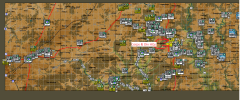Something I've noticed in allot of my games and have been meaning to bring up for a while is the tendency for the AI to move very high level HQs (Corps Division and the like) right up into the front lines.
Below is a recent example I captured in the "Race for Bastogne" scenario where the two highest ranking HQs for the American side (VIII Corps and 28th Infantry Division HQs) got moved right up to the scenario start front-line on "skyline drive". As much as I admired their offensive spirit this was a somewhat disadvantageous place to put themselves as they ended up ~25km behind my leading units and got cut off and destroyed, which no doubt produced severe problems on the AI's ability to resist for the rest of the game.
Day 1 05:30 (scenario start, both images were taken after manually surrendering so there are no intel issues)

Day 2 15:14

I'm not sure of any reason the AI would see to move these units so far forward, any ideas on the cause/solutions?
Below is a recent example I captured in the "Race for Bastogne" scenario where the two highest ranking HQs for the American side (VIII Corps and 28th Infantry Division HQs) got moved right up to the scenario start front-line on "skyline drive". As much as I admired their offensive spirit this was a somewhat disadvantageous place to put themselves as they ended up ~25km behind my leading units and got cut off and destroyed, which no doubt produced severe problems on the AI's ability to resist for the rest of the game.
Day 1 05:30 (scenario start, both images were taken after manually surrendering so there are no intel issues)

Day 2 15:14

I'm not sure of any reason the AI would see to move these units so far forward, any ideas on the cause/solutions?
Attachments
Last edited: